Growth Differentiation Factor-15 Correlates Inversely with Protease-Activated Receptor-1-Mediated Platelet Reactivity in Patients with Left Ventricular Assist Devices
Abstract
:1. Introduction
2. Results
3. Discussion
Limitations
4. Materials and Methods
4.1. Blood Sampling
4.2. Platelet Surface Expression of Activated Glycoprotein IIb/IIIa
4.3. Multiple Electrode Platelet Aggregometry (MEA)
4.4. Growth Differentiation Factor 15 (GDF-15)
4.5. Soluble P-Selectin
4.6. Clinical Endpoint
4.7. Statistics
5. Conclusions
Supplementary Materials
Author Contributions
Funding
Institutional Review Board Statement
Informed Consent Statement
Data Availability Statement
Conflicts of Interest
References
- Kirklin, J.K.; Naftel, D.C.; Pagani, F.D.; Kormos, R.L.; Stevenson, L.W.; Blume, E.D.; Myers, S.L.; Miller, M.A.; Baldwin, J.T.; Young, J.B. Seventh INTERMACS Annual Report: 15,000 Patients and Counting. J. Heart Lung Transplant. 2015, 34, 1495–1504. [Google Scholar] [CrossRef] [PubMed]
- Maltais, S.; Kilic, A.; Nathan, S.; Keebler, M.; Emani, S.; Ransom, J.; Katz, J.N.; Sheridan, B.; Brieke, A.; Egnaczyk, G.; et al. PREVENtion of HeartMate II Pump Thrombosis Through Clinical Management: The PREVENT Multi-Center Study. J. Heart Lung Transplant. 2017, 36, 1–12. [Google Scholar] [CrossRef] [PubMed] [Green Version]
- Potapov, E.V.; Antonides, C.; Crespo-Leiro, M.G.; Combes, A.; Färber, G.; Hannan, M.M.; Kukucka, M.; De Jonge, N.; Loforte, A.; Lund, L.H.; et al. 2019 EACTS Expert Consensus on Long-Term Mechanical Circulatory Support. Eur. J. Cardio Thorac. Surg. 2019, 56, 230–270. [Google Scholar] [CrossRef]
- Bootcov, M.R.; Bauskin, A.R.; Valenzuela, S.M.; Moore, A.G.; Bansal, M.; He, X.Y.; Zhang, H.P.; Donnellan, M.; Mahler, S.; Pryor, K.; et al. MIC-1, a Novel Macrophage Inhibitory Cytokine, Is a Divergent Member of the TGF-β Superfamily. Proc. Natl. Acad. Sci. USA 1997, 94, 11514–11519. [Google Scholar] [CrossRef] [PubMed] [Green Version]
- Farhan, S.; Freynhofer, M.K.; Brozovic, I.; Bruno, V.; Vogel, B.; Tentzeris, I.; Baumgartner-Parzer, S.; Huber, K.; Kautzky-Willer, A. Determinants of Growth Differentiation Factor 15 in Patients with Stable and Acute Coronary Artery Disease. A Prospective Observational Study. Cardiovasc. Diabetol. 2016, 15, 60. [Google Scholar] [CrossRef] [PubMed] [Green Version]
- Mullican, S.E.; Lin-Schmidt, X.; Chin, C.-N.; Chavez, J.A.; Furman, J.L.; Armstrong, A.A.; Beck, S.C.; South, V.J.; Dinh, T.Q.; Cash-Mason, T.D.; et al. GFRAL Is the Receptor for GDF15 and the Ligand Promotes Weight Loss in Mice and Nonhuman Primates. Nat. Med. 2017, 23, 1150–1157. [Google Scholar] [CrossRef]
- Suriben, R.; Chen, M.; Higbee, J.; Oeffinger, J.; Ventura, R.; Li, B.; Mondal, K.; Gao, Z.; Ayupova, D.; Taskar, P.; et al. Antibody-Mediated Inhibition of GDF15–GFRAL Activity Reverses Cancer Cachexia in Mice. Nat. Med. 2020, 26, 1264–1270. [Google Scholar] [CrossRef]
- Kempf, T.; Zarbock, A.; Widera, C.; Butz, S.; Stadtmann, A.; Rossaint, J.; Bolomini-Vittori, M.; Korf-Klingebiel, M.; Napp, L.C.; Hansen, B.; et al. GDF-15 Is an Inhibitor of Leukocyte Integrin Activation Required for Survival after Myocardial Infarction in Mice. Nat. Med. 2011, 17, 581–588. [Google Scholar] [CrossRef]
- Lok, S.I.; Winkens, B.; Goldschmeding, R.; van Geffen, A.J.P.; Nous, F.M.A.; van Kuik, J.; van der Weide, P.; Klöpping, C.; Kirkels, J.H.; Lahpor, J.R.; et al. Circulating Growth Differentiation Factor-15 Correlates with Myocardial Fibrosis in Patients with Non-Ischaemic Dilated Cardiomyopathy and Decreases Rapidly after Left Ventricular Assist Device Support. Eur. J. Heart Fail. 2012, 14, 1249–1256. [Google Scholar] [CrossRef] [Green Version]
- Ahmad, T.; Wang, T.; O’Brien, E.C.; Samsky, M.D.; Pura, J.A.; Lokhnygina, Y.; Rogers, J.G.; Hernandez, A.F.; Craig, D.; Bowles, D.E.; et al. Effects of Left Ventricular Assist Device Support on Biomarkers of Cardiovascular Stress, Fibrosis, Fluid Homeostasis, Inflammation, and Renal Injury. JACC Heart Fail. 2015, 3, 30–39. [Google Scholar] [CrossRef]
- Rossaint, J.; Vestweber, D.; Zarbock, A. GDF-15 Prevents Platelet Integrin Activation and Thrombus Formation. J. Thromb. Haemost. 2013, 11, 335–344. [Google Scholar] [CrossRef] [PubMed]
- Lippi, G.; Salvagno, G.L.; Danese, E.; Brocco, G.; Gelati, M.; Montagnana, M.; Sanchis-Gomar, F.; Favaloro, E.J. Serum Concentration of Growth Differentiation Factor-15 Is Independently Associated with Global Platelet Function and Higher Fibrinogen Values in Adult Healthy Subjects. Semin. Thromb. Hemost. 2017, 43, 621–628. [Google Scholar] [CrossRef] [PubMed]
- Arauna, D.; García, F.; Rodríguez-Mañas, L.; Marrugat, J.; Sáez, C.; Alarcón, M.; Wehinger, S.; Espinosa-Parrilla, Y.; Palomo, I.; Fuentes, E. Older Adults with Frailty Syndrome Present an Altered Platelet Function and an Increased Level of Circulating Oxidative Stress and Mitochondrial Dysfunction Biomarker GDF-15. Free Radic. Biol. Med. 2020, 149, 64–71. [Google Scholar] [CrossRef] [PubMed]
- Wallentin, L.; Hijazi, Z.; Andersson, U.; Alexander, J.H.; De Caterina, R.; Hanna, M.; Horowitz, J.D.; Hylek, E.M.; Lopes, R.D.; Åsberg, S.; et al. Growth Differentiation Factor 15, a Marker of Oxidative Stress and Inflammation, for Risk Assessment in Patients With Atrial Fibrillation. Circulation 2014, 130, 1847–1858. [Google Scholar] [CrossRef]
- Hagström, E.; James, S.K.; Bertilsson, M.; Becker, R.C.; Himmelmann, A.; Husted, S.; Katus, H.A.; Steg, P.G.; Storey, R.F.; Siegbahn, A.; et al. Growth Differentiation Factor-15 Level Predicts Major Bleeding and Cardiovascular Events in Patients with Acute Coronary Syndromes: Results from the PLATO Study. Eur. Heart J. 2016, 37, 1325–1333. [Google Scholar] [CrossRef] [PubMed] [Green Version]
- Berg, D.D.; Ruff, C.T.; Jarolim, P.; Giugliano, R.P.; Nordio, F.; Lanz, H.J.; Mercuri, M.F.; Antman, E.M.; Braunwald, E.; Morrow, D.A. Performance of the ABC Scores for Assessing the Risk of Stroke or Systemic Embolism and Bleeding in Patients With Atrial Fibrillation in ENGAGE AF-TIMI 48. Circulation 2019, 139, 760–771. [Google Scholar] [CrossRef]
- Gremmel, T.; Michelson, A.D.; Frelinger, A.L.; Bhatt, D.L. Novel Aspects of Antiplatelet Therapy in Cardiovascular Disease. Res. Pract. Thromb. Haemost. 2018, 2, 439–449. [Google Scholar] [CrossRef]
- Tscharre, M.; Michelson, A.D.; Gremmel, T. Novel Antiplatelet Agents in Cardiovascular Disease. J. Cardiovasc. Pharmacol. Ther. 2020, 25, 191–200. [Google Scholar] [CrossRef]
- Gremmel, T.; Steiner, S.; Seidinger, D.; Koppensteiner, R.; Panzer, S.; Kopp, C.W. In Vivo and Protease-Activated Receptor-1-Mediated Platelet Activation but Not Response to Antiplatelet Therapy Predict Two-Year Outcomes after Peripheral Angioplasty with Stent Implantation. Thromb. Haemost. 2014, 112, 474–482. [Google Scholar] [CrossRef] [Green Version]
- Michelson, A.D.; Barnard, M.R.; Krueger, L.A.; Valeri, C.R.; Furman, M.I. Circulating Monocyte-Platelet Aggregates Are a More Sensitive Marker of in Vivo Platelet Activation than Platelet Surface P-Selectin: Studies in Baboons, Human Coronary Intervention, and Human Acute Myocardial Infarction. Circulation 2001, 104, 1533–1537. [Google Scholar] [CrossRef] [Green Version]
- Furman, M.I.; Benoit, S.E.; Barnard, M.R.; Valeri, C.R.; Borbone, M.L.; Becker, R.C.; Hechtman, H.B.; Michelson, A.D. Increased Platelet Reactivity and Circulating Monocyte-Platelet Aggregates in Patients with Stable Coronary Artery Disease. J. Am. Coll. Cardiol. 1998, 31, 352–358. [Google Scholar] [CrossRef] [Green Version]
- Shattil, S.J.; Hoxie, J.A.; Cunningham, M.; Brass, L.F. Changes in the Platelet Membrane Glycoprotein IIb.IIIa Complex during Platelet Activation. J. Biol. Chem. 1985, 260, 11107–11114. [Google Scholar] [CrossRef]
- Tóth, O.; Calatzis, A.; Penz, S.; Losonczy, H.; Siess, W. Multiple Electrode Aggregometry: A New Device to Measure Platelet Aggregation in Whole Blood. Thromb. Haemost. 2006, 96, 781–788. [Google Scholar] [CrossRef] [PubMed]
- Sibbing, D.; Aradi, D.; Alexopoulos, D.; ten Berg, J.; Bhatt, D.L.; Bonello, L.; Collet, J.-P.; Cuisset, T.; Franchi, F.; Gross, L.; et al. Updated Expert Consensus Statement on Platelet Function and Genetic Testing for Guiding P2Y12 Receptor Inhibitor Treatment in Percutaneous Coronary Intervention. JACC Cardiovasc. Interv. 2019, 12, 1521–1537. [Google Scholar] [CrossRef]
- Mayer, K.; Bernlochner, I.; Braun, S.; Schulz, S.; Orban, M.; Morath, T.; Cala, L.; Hoppmann, P.; Schunkert, H.; Laugwitz, K.-L.; et al. Aspirin Treatment and Outcomes After Percutaneous Coronary Intervention. J. Am. Coll. Cardiol. 2014, 64, 863–871. [Google Scholar] [CrossRef] [Green Version]
- Sibbing, D.; Braun, S.; Morath, T.; Mehilli, J.; Vogt, W.; Schömig, A.; Kastrati, A.; von Beckerath, N. Platelet Reactivity after Clopidogrel Treatment Assessed with Point-of-Care Analysis and Early Drug-Eluting Stent Thrombosis. J. Am. Coll. Cardiol. 2009, 53, 849–856. [Google Scholar] [CrossRef] [Green Version]
- Sibbing, D.; Schulz, S.; Braun, S.; Morath, T.; Stegherr, J.; Mehilli, J.; Schömig, A.; Von Beckerath, N.; Kastrati, A. Antiplatelet Effects of Clopidogrel and Bleeding in Patients Undergoing Coronary Stent Placement. J. Thromb. Haemost. 2010, 8, 250–256. [Google Scholar] [CrossRef]
- Michelson, A.D. Antiplatelet Therapies for the Treatment of Cardiovascular Disease. Nat. Rev. Drug Discov. 2010, 9, 154–169. [Google Scholar] [CrossRef]
- de Bruyn, K.M.T.; Zwartkruis, F.J.T.; de Rooij, J.; Akkerman, J.-W.N.; Bos, J.L. The Small GTPase Rap1 Is Activated by Turbulence and Is Involved in Integrin AIIbβ3-Mediated Cell Adhesion in Human Megakaryocytes. J. Biol. Chem. 2003, 278, 22412–22417. [Google Scholar] [CrossRef] [Green Version]
- Lindholm, D.; Hagström, E.; James, S.K.; Becker, R.C.; Cannon, C.P.; Himmelmann, A.; Katus, H.A.; Maurer, G.; López-Sendón, J.L.; Steg, P.G.; et al. Growth Differentiation Factor 15 at 1 Month After an Acute Coronary Syndrome Is Associated with Increased Risk of Major Bleeding. J. Am. Heart Assoc. 2017, 6, e005580. [Google Scholar] [CrossRef]
- Martorell, L.; Martínez-González, J.; Rodríguez, C.; Gentile, M.; Calvayrac, O.; Badimon, L. Thrombin and Protease-Activated Receptors (PARs) in Atherothrombosis. Thromb. Haemost. 2008, 99, 305–315. [Google Scholar] [CrossRef] [PubMed]
- Gremmel, T.; Eslam, R.B.; Koppensteiner, R.; Lang, I.M.; Panzer, S. Prasugrel Reduces Agonists’ Inducible Platelet Activation and Leukocyte-Platelet Interaction More Efficiently than Clopidogrel. Cardiovasc. Ther. 2013, 31, e40–e45. [Google Scholar] [CrossRef] [PubMed]
- Wadowski, P.P.; Pultar, J.; Weikert, C.; Eichelberger, B.; Panzer, B.; Huber, K.; Lang, I.M.; Koppensteiner, R.; Panzer, S.; Gremmel, T. Protease-Activated Receptor-Mediated Platelet Aggregation in Acute Coronary Syndrome Patients on Potent P2Y 12 Inhibitors. Res. Pract. Thromb. Haemost. 2019, 3, 383–390. [Google Scholar] [CrossRef] [PubMed] [Green Version]
- Tricoci, P.; Huang, Z.; Held, C.; Moliterno, D.J.; Armstrong, P.W.; Van De Werf, F.; White, H.D.; Aylward, P.E.; Wallentin, L.; Chen, E.; et al. Thrombin-Receptor Antagonist Vorapaxar in Acute Coronary Syndromes. N. Engl. J. Med. 2012, 366, 20–33. [Google Scholar] [CrossRef] [Green Version]
- Pulcinelli, F.M.; Pignatelli, P.; Celestini, A.; Riondino, S.; Gazzaniga, P.P.; Violi, F. Inhibition of Platelet Aggregation by Aspirin Progressively Decreases in Long-Term Treated Patients. J. Am. Coll. Cardiol. 2004, 43, 979–984. [Google Scholar] [CrossRef] [Green Version]
- Hijazi, Z.; Oldgren, J.; Lindbäck, J.; Alexander, J.H.; Connolly, S.J.; Eikelboom, J.W.; Ezekowitz, M.D.; Held, C.; Hylek, E.M.; Lopes, R.D.; et al. The Novel Biomarker-Based ABC (Age, Biomarkers, Clinical History)-Bleeding Risk Score for Patients with Atrial Fibrillation: A Derivation and Validation Study. Lancet 2016, 387, 2302–2311. [Google Scholar] [CrossRef]
- Song, L.; Söderholm, M.; Svensson, E.H.; Borné, Y.; Engström, G. Circulating Growth Differentiation Factor 15 Levels Are Associated With Risk of Both Intracerebral and Subarachnoid Hemorrhage. Front. Neurol. 2021, 12, 664010. [Google Scholar] [CrossRef]
- Patrono, C.; García Rodríguez, L.A.; Landolfi, R.; Baigent, C. Low-Dose Aspirin for the Prevention of Atherothrombosis. N. Engl. J. Med. 2005, 353, 2373–2383. [Google Scholar] [CrossRef] [Green Version]
- Santilli, F.; Rocca, B.; De Cristofaro, R.; Lattanzio, S.; Pietrangelo, L.; Habib, A.; Pettinella, C.; Recchiuti, A.; Ferrante, E.; Ciabattoni, G.; et al. Platelet Cyclooxygenase Inhibition by Low-Dose Aspirin Is Not Reflected Consistently by Platelet Function Assays. J. Am. Coll. Cardiol. 2009, 53, 667–677. [Google Scholar] [CrossRef]
- Tscharre, M.; Wittmann, F.; Kitzmantl, D.; Lee, S.; Eichelberger, B.; Wadowski, P.P.; Laufer, G.; Wiedemann, D.; Forstner-Bergauer, B.; Ay, C.; et al. Platelet Activation and Aggregation in Different Centrifugal-Flow Left Ventricular Assist Devices. Platelets 2021, 33, 249–256. [Google Scholar] [CrossRef]
- Schulman, S.; Kearon, C. Definition of Major Bleeding in Clinical Investigations of Antihemostatic Medicinal Products in Non-Surgical Patients. J. Thromb. Haemost. 2005, 3, 692–694. [Google Scholar] [CrossRef] [PubMed]
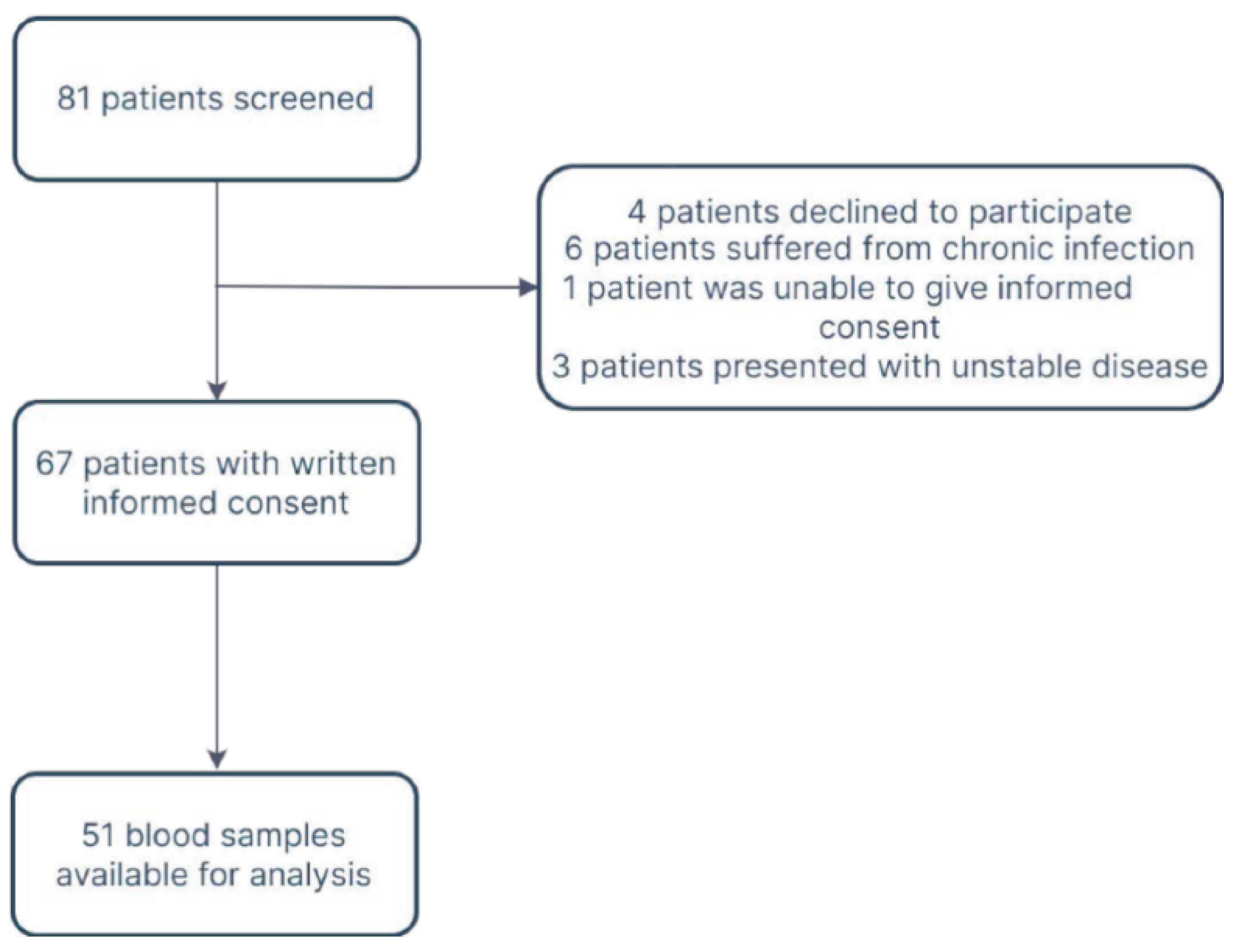
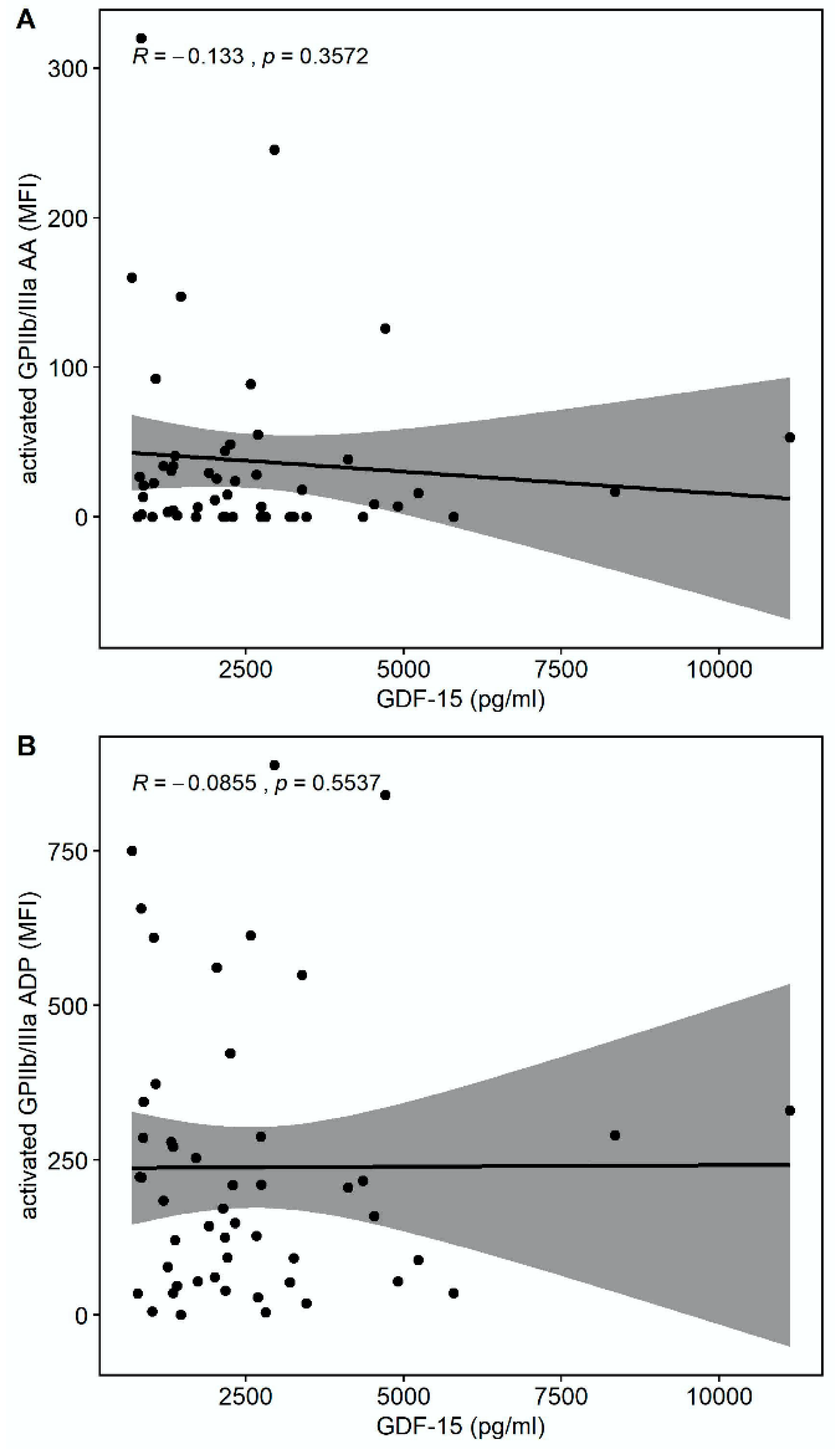

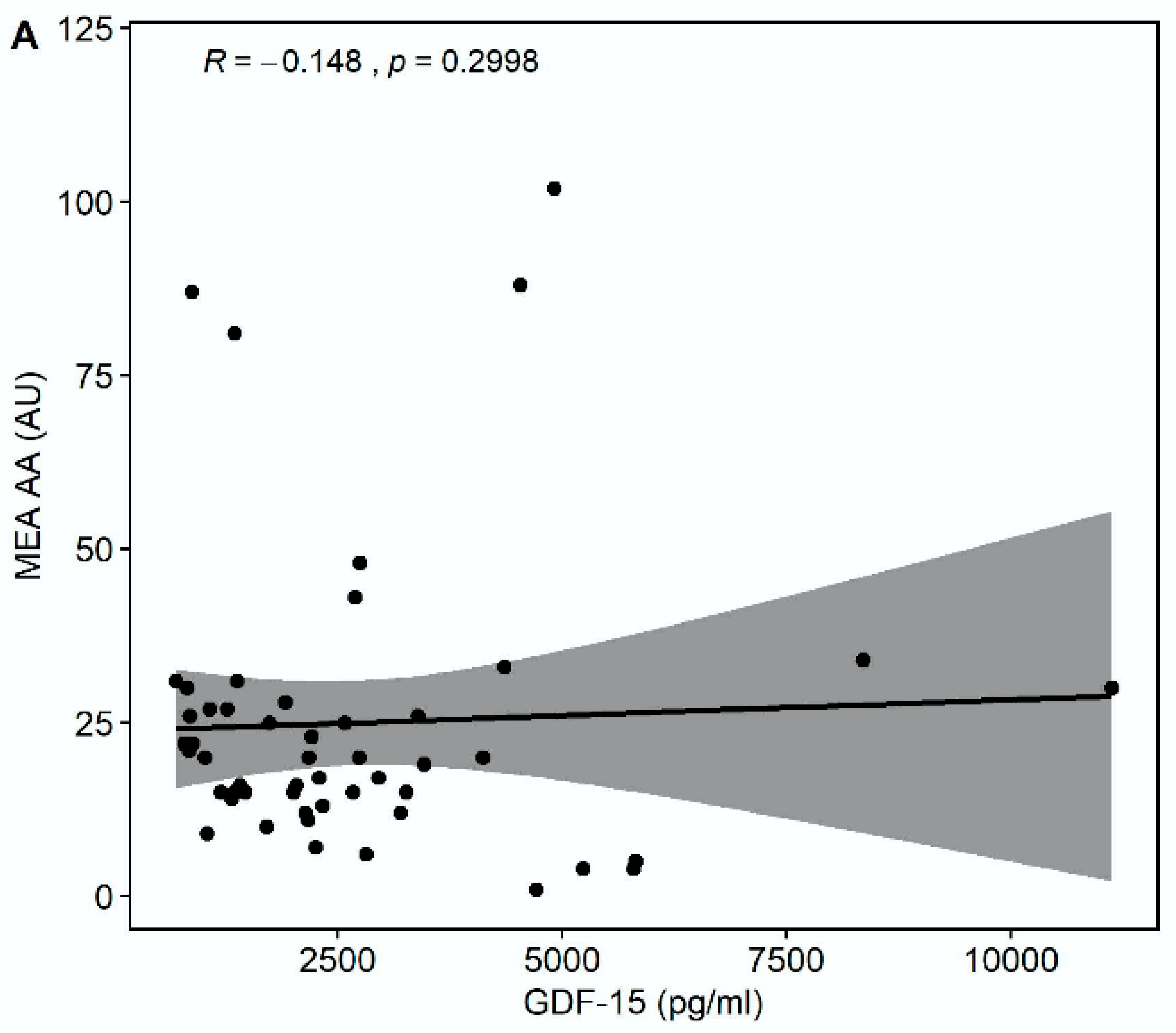
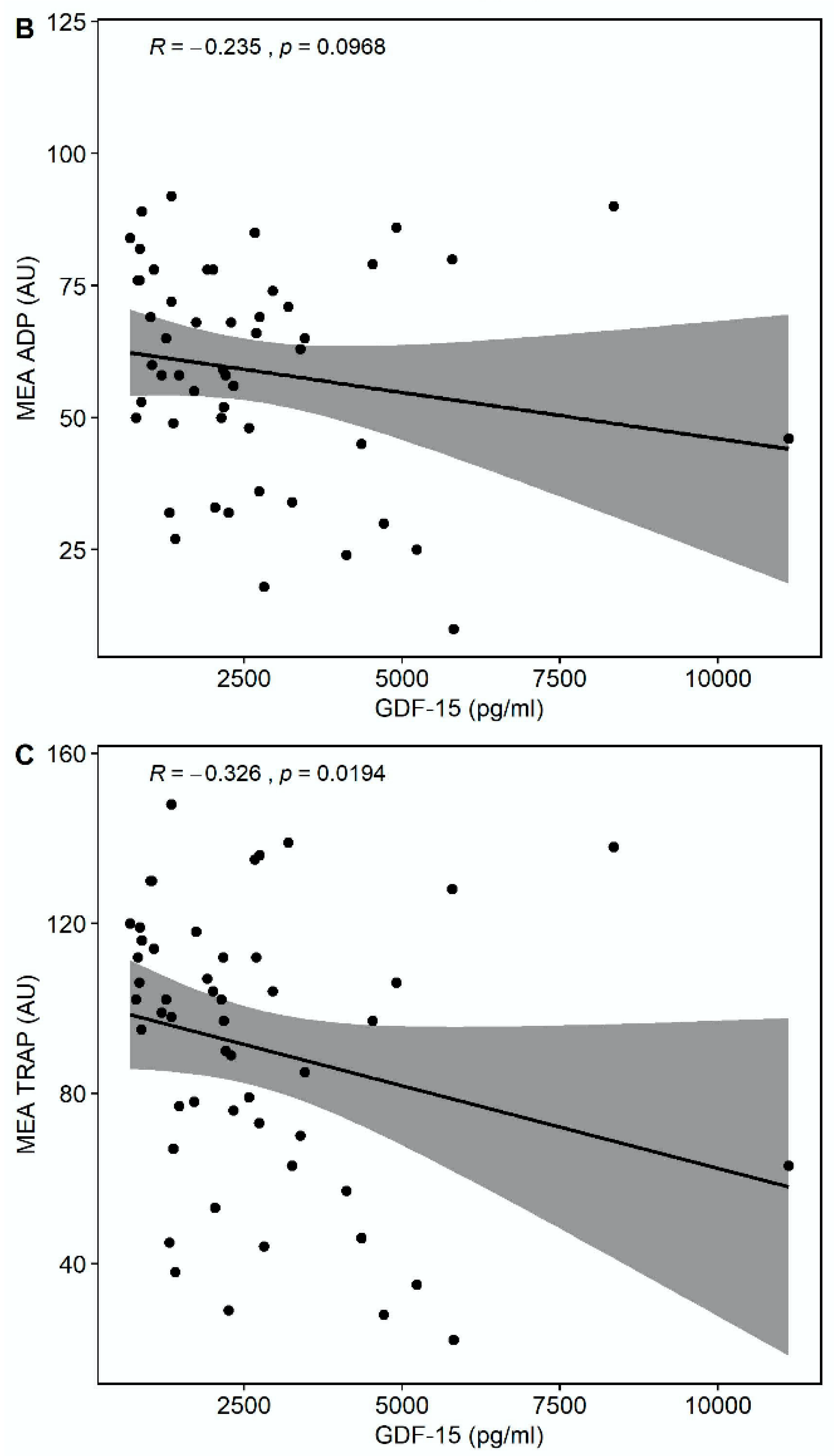
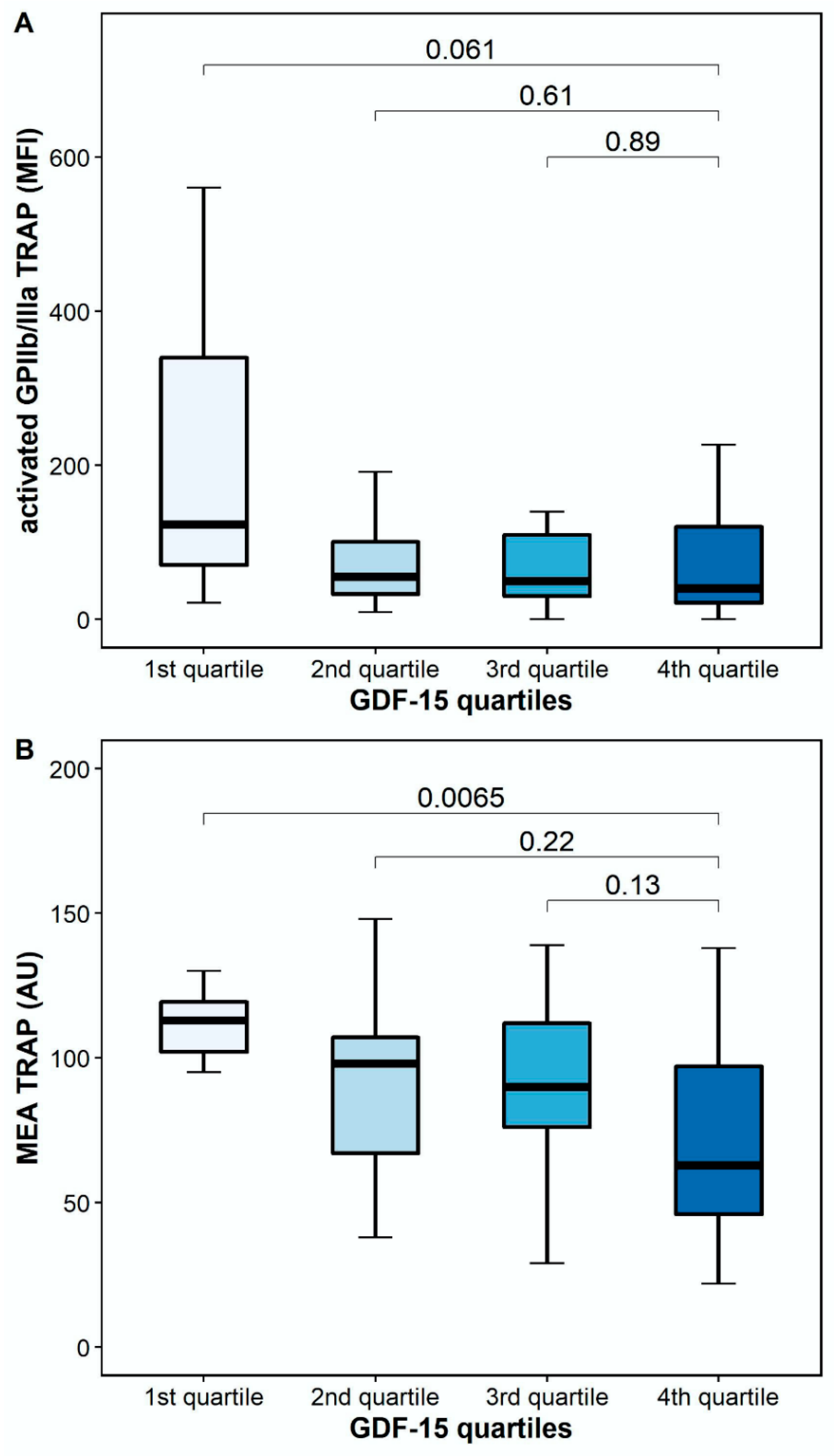
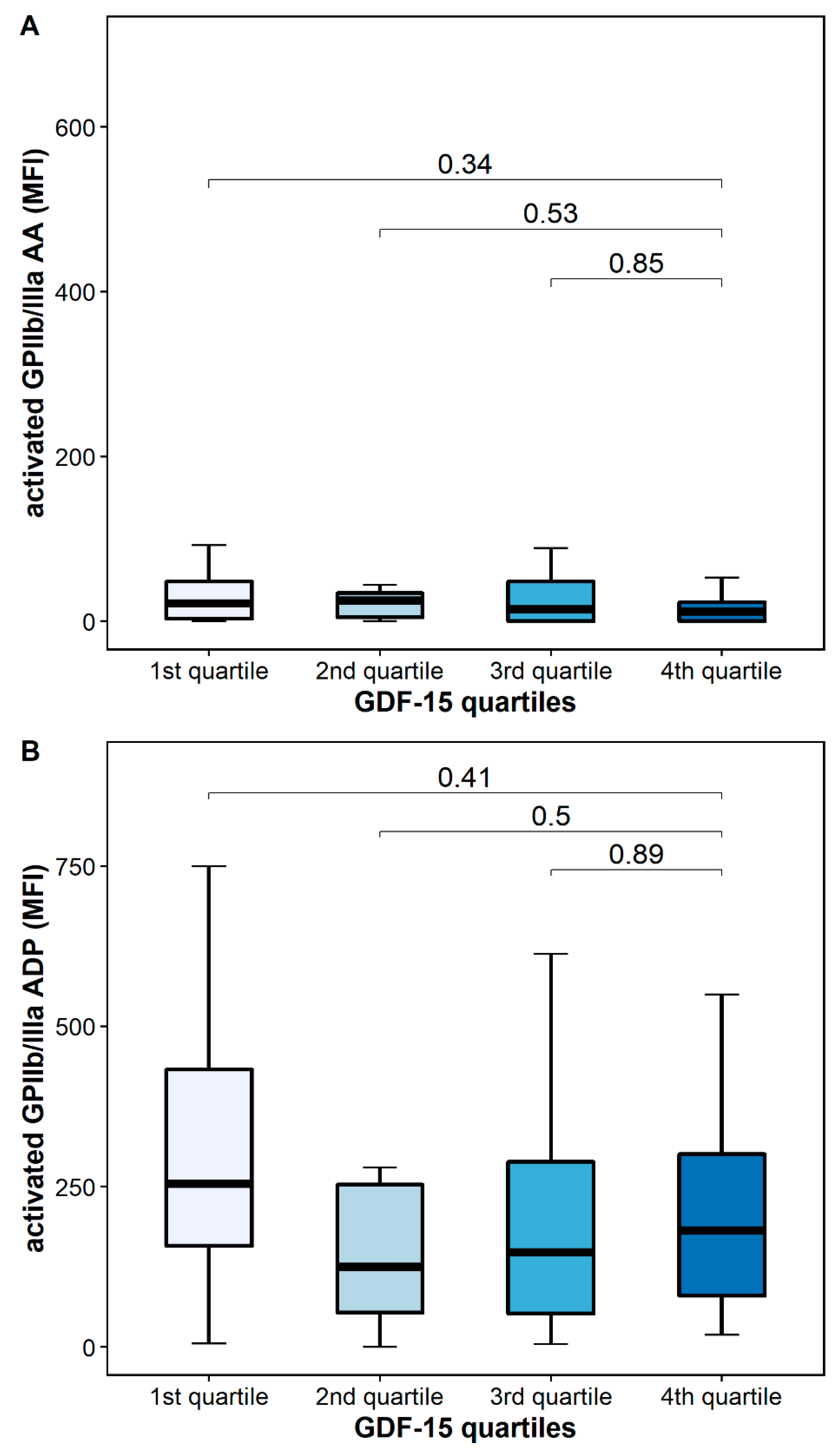

| Entire Cohort | |
|---|---|
| (n = 51) | |
| GDF-15, pg/mL | 2181 [1336–3231] |
| Age, years | 62 [55–69] |
| Sex, No. (%): | |
| Female patients | 5 (9.8%) |
| Male patients | 46 (90.2%) |
| Body mass index, kg/m2 | 29.4 [25.9–31.8] |
| Type of cardiomyopathy, No. (%): | |
| Ischemic CMP | 38 (74.5%) |
| Dilatative CMP | 13 (25.5%) |
| Ventricular assist device, No. (%): | |
| HVAD | 15 (29.4%) |
| HM2 | 2 (3.92%) |
| HM3 | 34 (66.7%) |
| Flow min−1 | 4.90 [4.30–5.18] |
| Speed RPM | 5350 [2925–5700] |
| History of arterial hypertension, No. (%) | 29 (56.9%) |
| Hyperlipidemia, No. (%) | 23 (45.1%) |
| Diabetes mellitus, No. (%) | 10 (19.6%) |
| Atrial fibrillation, No. (%) | 20 (39.2%) |
| Cerebral artery disease, No. (%) | 2 (3.92%) |
| Peripheral artery disease, No. (%) | 2 (3.92%) |
| Hemoglobin, g/dL | 13.3 [11.7–14.4] |
| Thrombocytes, G/L | 222 [178–265] |
| White blood cell count, G/L | 8.28 [6.25–9.73] |
| Creatinine, mg/dL | 1.18 [1.02–1.64] |
| INR | 2.4 [2.1–2.7] |
| proBNP, pg/mL | 1022 [567–1691] |
| High sensitivity C-reactive protein, mg/dL | 0.27 [0.13–0.59] |
| Vitamin K antagonist, No. (%) | 51 (100%) |
| Aspirin, No. (%) | 51 (100%) |
| Clopidogrel, No. (%) | 2 (3.9%) |
| Statin, No. (%) | 34 (69.4%) |
| ACE-I or ARB, No. (%) | 36 (70.6%) |
| MRA, No. (%) | 28 (54.9%) |
| Furosemide, No. (%) | 45 (88.2%) |
| Beta blocker, No. (%) | 34 (68.0%) |
| 1st Quartile | 2nd Quartile | 3rd Quartile | 4th Quartile | p-Value | |
|---|---|---|---|---|---|
| n = 13 | n = 13 | n = 13 | n = 12 | ||
| Age, years | 56 [52–68] | 59 [56–64] | 61 [56–71] | 69 [61–71] | 0.384 |
| Sex, No. (%): | 0.536 | ||||
| Female patients | 0 (0.0%) | 2 (15.4%) | 1 (7.7%) | 2 (16.7%) | 0.536 |
| Male patients | 13 (100%) | 11 (84.6%) | 12 (92.3%) | 10 (83.3%) | |
| Ventricular assist device, No. (%): | |||||
| HVAD | 5 (38.5%) | 1 (7.7%) | 5 (38.5%) | 4 (33.3%) | 0.476 |
| HM2 | 1 (7.7%) | 1 (7.7%) | 0 (0.0%) | 0 (0.0%) | |
| HM3 | 7 (53.8%) | 11 (84.6%) | 8 (61.5%) | 8 (66.7%) | |
| Body mass index, kg/m2 | 31.0 [28.2–35.1] | 28.4 [25.6–30.4] | 31.0 [28.8–32.8] | 29.0 [27.0–30.3] | 0.279 |
| Type of cardiomyopathy, No. (%): | |||||
| Ischemic CMP | 10 (76.9%) | 9 (69.2%) | 8 (61.5%) | 11 (91.7%) | 0.420 |
| Dilatative CMP | 3 (23.1%) | 4 (30.8%) | 5 (38.5%) | 1 (8.33%) | |
| Flow, min-1 | 5.3 [5.0–5.5] | 4.9 [4.0–5.0] | 4.7 [4.5–4.9] | 4.7 [4.2–5.1] | 0.089 |
| Speed RPM | 4200 [2850–5750] | 5700 [5600–6000] | 5200 [2775–5325] | 5200 [2810–5450] | 0.024 |
| History of arterial hypertension, No. (%) | 7 (53.8%) | 9 (69.2%) | 7 (53.8%) | 6 (50.0%) | 0.768 |
| Hyperlipidemia, No. (%) | 4 (30.8%) | 8 (61.5%) | 7 (53.8%) | 4 (33.3%) | 0.312 |
| Atrial fibrillation, No. (%) | 3 (23.1%) | 5 (38.5%) | 7 (53.8%) | 5 (41.7%) | 0.497 |
| Cerebral artery disease, No. (%) | 0 (0.0%) | 0 (0.0%) | 0 (0.0%) | 2 (16.7%) | 0.040 |
| Peripheral artery disease, No. (%) | 0 (0.0%) | 1 (7.7%) | 1 (7.7%) | 0 (0.0%) | 1.000 |
| Hemoglobin, g/dL | 14.4 [13.2–16.5] | 13.6 [12.0–14.1] | 13.5 [12.2–14.4] | 11.7 [10.8–12.6] | 0.010 |
| Thrombocytes, G/L | 250 [195–278] | 222 [188–244] | 225 [183–279] | 177 [154–249] | 0.551 |
| White blood cell count, G/L | 7.1 [6.4–8.5] | 8.6 [5.6–10.3] | 8.0 [5.9–9.8] | 8.7 [7.6–10.1] | 0.413 |
| Creatinine, mg/dL | 1.0 [0.9–1.1] | 1.1 [1.1–1.4] | 1.3 [1.0–1.6] | 1.7 [1.1–2.1] | 0.008 |
| INR | 2.5 [2.3–2.6] | 2.5 [2.2–2.7] | 2.2 [2.1–2.7] | 2.2 [2.1–2.4] | 0.328 |
| High sensitivity C-reactive protein, mg/L | 0.2 [0.1–0.3] | 0.2 [0.1–0.4] | 0.4 [0.2–0.7] | 0.6 [0.2–2.2] | 0.050 |
| Vitamin K antagonist, No. (%) | 13 (100%) | 13 (100%) | 13 (100%) | 12 (100%) | . |
| Aspirin, No. (%) | 13 (100%) | 13 (100%) | 13 (100%) | 12 (100%) | . |
| Clopidogrel, No. (%) | 0 (0.0%) | 0 (0.0%) | 2 (15.4%) | 0 (0.0%) | 0.219 |
| ACE-I or ARB, No. (%) | 8 (61.5%) | 10 (76.9%) | 9 (69.2%) | 6 (50.0%) | 0.570 |
| Furosemide, No. (%) | 10 (76.9%) | 13 (100%) | 10 (76.9%) | 12 (100%) | 0.145 |
| Statin, No. (%) | 7 (58.3%) | 10 (76.9%) | 8 (61.5%) | 9 (81.8%) | 0.562 |
Publisher’s Note: MDPI stays neutral with regard to jurisdictional claims in published maps and institutional affiliations. |
© 2022 by the authors. Licensee MDPI, Basel, Switzerland. This article is an open access article distributed under the terms and conditions of the Creative Commons Attribution (CC BY) license (https://creativecommons.org/licenses/by/4.0/).
Share and Cite
Tscharre, M.; Wittmann, F.; Kitzmantl, D.; Lee, S.; Eichelberger, B.; Wadowski, P.P.; Laufer, G.; Wiedemann, D.; Panzer, S.; Perkmann, T.; et al. Growth Differentiation Factor-15 Correlates Inversely with Protease-Activated Receptor-1-Mediated Platelet Reactivity in Patients with Left Ventricular Assist Devices. Pharmaceuticals 2022, 15, 484. https://doi.org/10.3390/ph15040484
Tscharre M, Wittmann F, Kitzmantl D, Lee S, Eichelberger B, Wadowski PP, Laufer G, Wiedemann D, Panzer S, Perkmann T, et al. Growth Differentiation Factor-15 Correlates Inversely with Protease-Activated Receptor-1-Mediated Platelet Reactivity in Patients with Left Ventricular Assist Devices. Pharmaceuticals. 2022; 15(4):484. https://doi.org/10.3390/ph15040484
Chicago/Turabian StyleTscharre, Maximilian, Franziska Wittmann, Daniela Kitzmantl, Silvia Lee, Beate Eichelberger, Patricia P. Wadowski, Günther Laufer, Dominik Wiedemann, Simon Panzer, Thomas Perkmann, and et al. 2022. "Growth Differentiation Factor-15 Correlates Inversely with Protease-Activated Receptor-1-Mediated Platelet Reactivity in Patients with Left Ventricular Assist Devices" Pharmaceuticals 15, no. 4: 484. https://doi.org/10.3390/ph15040484
APA StyleTscharre, M., Wittmann, F., Kitzmantl, D., Lee, S., Eichelberger, B., Wadowski, P. P., Laufer, G., Wiedemann, D., Panzer, S., Perkmann, T., Zimpfer, D., & Gremmel, T. (2022). Growth Differentiation Factor-15 Correlates Inversely with Protease-Activated Receptor-1-Mediated Platelet Reactivity in Patients with Left Ventricular Assist Devices. Pharmaceuticals, 15(4), 484. https://doi.org/10.3390/ph15040484








